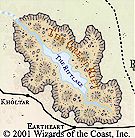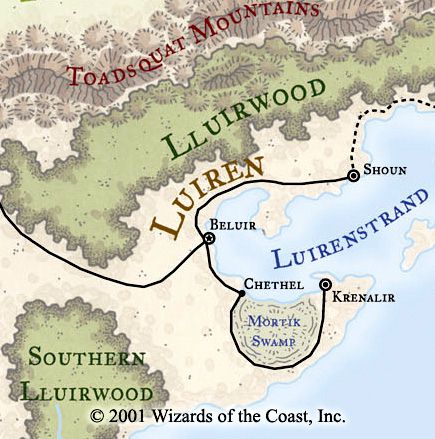Rand's Travelogue
More of the Shining South!
By Rand Sharpsword
Rand Sharpsword, collector of bits of travel and geographical information, brings you further details about the Shining South. Rand provides these to supplement the information found in the Forgotten Realms Campaign Setting.
Great Rift Location
Glitterdelve (Metropolis, 26,000): Glitterdelve's inhabitants don't waste time on politics or religion when there's gold and silver to be mined. Despite centuries of avid mining, there's still gold to be found. The dukes, barons, and counts who parade through Glitterdelve in struggles for status and position make sure of one thing: that the gold keeps coming out of the ground into the gold dwarves' coffers.
Halruaa Location
Lake Maeru: Smaller and much easier to sail than Lake Halruaa. Lake Maeru's fisheries help feed the people of Halruaa's towns as well as the electrum miners at nearby Maeruhal.

Luiren Location
Shoun (Small City, 5,500): Shoun on Luiren's east coast is such a pleasant place to live that hin outside its walls frequently greet each other by saying "How long since you've been to Shoun?" Still, the city stays small because aside from enjoying the sea air and the pleasant breezes off the hills, there's not much to do in Shoun except sit around and get fat. In Luiren, getting fat is a social gaffe that's hard to live down.
Major Social Groups in Luiren
All of the following major groups have revolving memberships and regularly field teams in the Games. The groups all get along fairly well with each other, as you might expect from groups whose members shift serially between allegiances.
Hin Fist: Hin Fist is the most consistent and conservative of the groups, if only because only actual practicing monks can be full members. Hin Fist is also the only major group that occasionally accepts non-halflings, because humans and other nonhin usually don't understand the spirit in which Luiren's social game is played. Hin Fist members sometimes participate in the Games, but usually beg off citing more pressing concerns, such as killing a marauding group of tall mouthers or performing dozens of one-armed pushups.
Ruling Party: The Ruling Party hasn't ruled for two hundred years, but prior to the rise of Yondalla's Children, they ran things. They've kept the name because they do, in fact, throw excellent parties.
Tymora's Followers: Tymora isn't in fashion in Luiren since Yondalla's Children advised that human deities weren't as Luiren (their pet adjective) as halfling gods of luck like Brandobaris. But Tymora's Followers like to say instead that the humans worship a halfling deity. They're the most individualistic of the halfling groups, but some of the most fervent competitors in the Games.
Yondalla's Children: Yondalla's Children rule Luiren, which has a benevolent theocracy with an extremely light touch. When big decisions have to be made, a priest of Yondalla is likely to be the one to make them. Organization beyond that one simple fact is difficult to discern.
Yondalla's Children have one serious concern about the very near future: Alaundo's Roll of Years lists 1386 DR as the Year of the Halfling's Lament. Few halflings take warnings from the Roll of Years at all seriously, but many members of Yondalla's Children are convinced that something bad will take place in 1386 DR. How bad? They don't know.
Yondalla's monks maintain rivalry with the monks of the Hin Fist school. It's not a serious rivalry: no one beats each other up beyond what a couple cure light wounds spells can patch up.
More Regional History for Luiren
Unlike human realms that measure their success by how much territory they occupy, the wealth that flows through their coffers, or how many people they govern, the hin of Luiren judge themselves by how well they govern and police their own chosen land. This is not to say that Luiren's policies don't contain a smidgen of aggression. In Luiren's case, that aggression plays out at the expense of the belligerent tendencies of its human and half-elven neighbors. Every hundred or two hundred years, the hin of Luiren goad one of their neighbors into invading. One of the hin's favorite jokes plays into this pattern. Noting that the history of northern Faerûn is to be conquered by successive waves of people from the south, the hin say that it's the eventual destiny of their kind to rule all the lands of the Inner Sea. The truth is that the hin don't much care for the idea of such conquests, but they know that it drives the humans who live around them crazy to hear it.
The Dambrathii (who showed the bad sense to invade in 939 DR, the Year of the Vengeful Halfling) and the kingdom of Estagund (which has invaded several times over the centuries) should know better by now -- Luiren has proven a killing ground for would-be invaders. At first invaders make good progress, destroying one or the other town or area of the countryside. But deep within Luiren, every-other house, wagon, or road turns out to be booby-trapped. Rogues strike like assassins attack from all sides, in light or in darkness. Strange magic items that never seem to be used in times of peace turn up in halfling champions' hands, and the invasion turns into a forced march of retreat . . . followed by outright slaughter if the invaders made the mistake of slaying and pillaging during their invasion.
The histories written by Luiren's neighbors and other human nations don't like to mention these episodes, so common folk of other lands may think of Luiren as a weak and vulnerable nation. Halflings, who usually know better, grin when they hear such talk, knowing that some would-be human conqueror will misread history and give conquest another chance.

